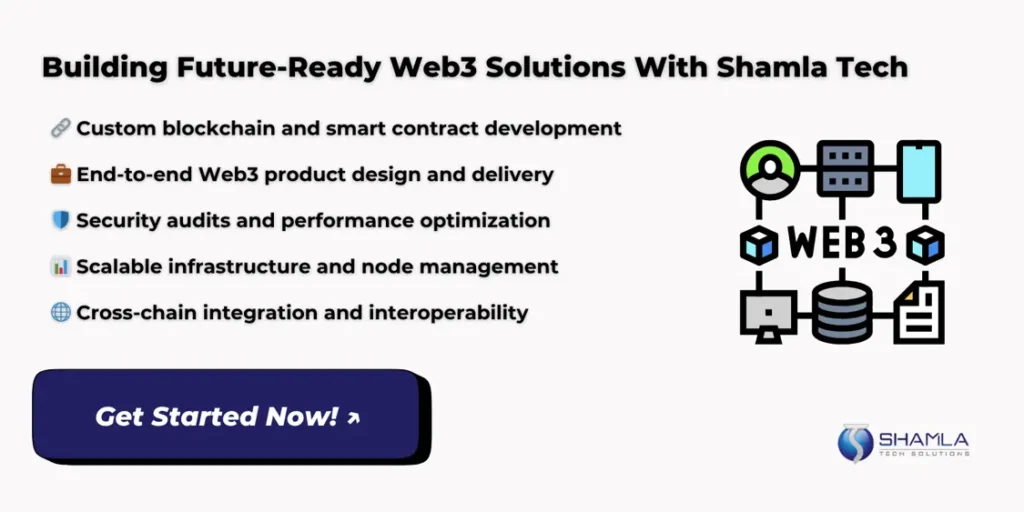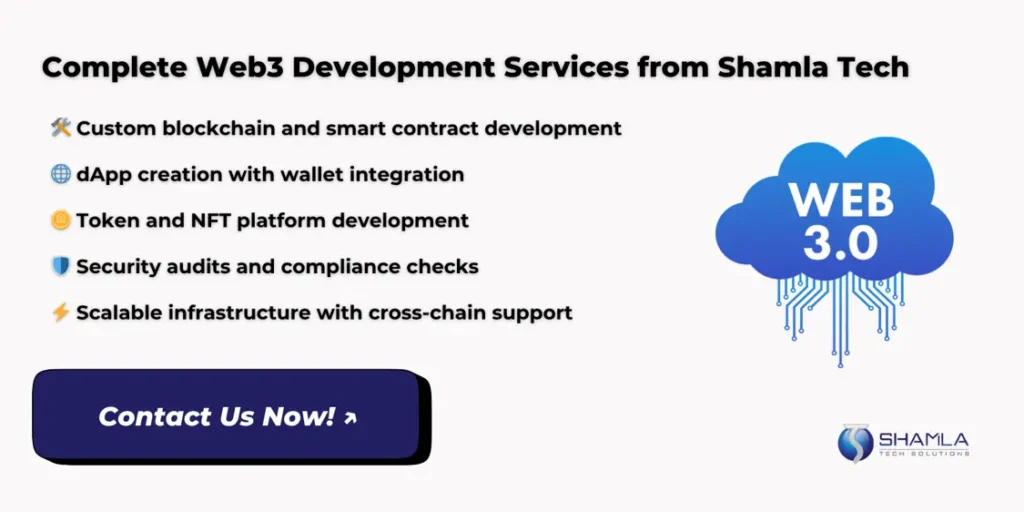Web3 development for startups helps founders add clear ownership, tamper-proof records, and token models to products. This short guide explains core tools, expected costs, and step-by-step plans.
It covers ledger options, smart contract languages, node hosting, wallet integration, APIs, continuous delivery, and testing steps. You will see what a small in-house team must do and what external Web3 development services handle, including security audits, monitoring, and node operations. The roadmap lays out stages: proof of concept, MVP build, security review, beta testing, and public launch with realistic timelines. Use this to pick a stack, set a budget, and set delivery targets and measure progress weekly.
Choosing the Right Tech Stack for Web3 Development
Core Protocols and Runtime Choices
Smart Contracts and Tooling
Frontend, Wallets, and Integration
Build web and mobile views to talk to wallets and back ends cleanly. Use straightforward Web3 libraries like ethers.js or web3.js and wallet SDKs for connect and sign flows. Keep UI work off the chain; only store needed state in contracts. Use basic back-end indexers or subgraphs to serve fast queries and pages.
Protect keys on servers and require user signatures for sensitive actions. Plan integration points early in your Web3 development roadmap so data, cache, and sync match contract releases. Web3 development for startups must test wallet flows on multiple browsers and devices before launch and run crosschain tests.
Scaling, Ops, and Roadmap Alignment
Plan growth with clear ops tasks and simple monitoring. Track node health, transaction success, error rates, and gas spend. Use autoscale for indexers and API layers when load rises. Prepare rollback steps and feature flags for contract fixes and UI updates. Schedule regular audits, library updates, and backups.
Put these tasks on your release calendar so each step fits the product plan and fundraising timeline. If your team lacks ops depth, hire contractors or use managed providers. Contract a reliable Web3 development company like Shamla Tech for ongoing Web3 development services to run infra, handle incidents fast, and reporting.
Web3 Development Cost Factors for Startups
1. Labor and Team Setup
Decide who builds and how long they stay. Hiring full-time devs costs more each month but gives control. For a first test, a small team with one smart-contract coder, one frontend dev, and one backend or node engineer usually works. Using freelancers cuts payroll but needs more management.
Add a project lead and budget for basic security checks and audits. Log hours, milestones, and deliverables to stop scope creep. These staff and contract choices determine Web3 development cost and shape hiring needs for Web3 development for startups. Always list tasks, hours, and risks before any agreement. Review monthly and adjust.
2. Smart-contract Complexity and Audits
Complex smart code raises bills. Simple contracts with clear rules cost less and test faster. Complex token logic, cross-chain bridges, or on-chain market features need more code, more tests, and formal checks. Audits by trusted firms find flaws but add months and fees. Bug bounties and insurance add extra spend.
Use a staged review plan: internal tests, external audit, and live bug bounty. Use reliable Web3 development services for audits and deployment if you lack trust or time. Budget these checks early since they drive overall Web3 development cost and reduce failure risk. Plan funds for retests and fixes immediately.
3. Infrastructure and Running Costs
Infrastructure bills keep growing with users. Running nodes, indexing services, and backups use servers and bandwidth. Using node providers or RPC services cuts setup work but adds monthly fees. Plan for these items:
Node access or hosted RPC
Indexer or search layer
Backups and monitoring
Cache frequent queries off-chain to save chain reads. Measure gas spend and set fee limits. Factor in testnet fees and mainnet run fees in your budget. These line items make up much of Web3 development cost and must fit the plan for Web3 development for startups. Review usage monthly and cut waste.
4. Tools, Licenses, and Ongoing Ops
Tool and license fees are steady drains. Paid IDEs, analytics, monitoring, and team tools add monthly bills. Buy or subscribe to:
CI/CD and build tools
Analytics and node dashboards
Wallet SDKs and key management tools
Plan for ongoing ops: backups, library updates, and security patches. Include support for upgrades and emergency fixes in your release plan. Factor these steady fees into long-term forecasts. These regular fees affect overall Web3 development cost and must be placed on the calendar tied to your Web3 development roadmap so funding rounds reflect real run rates. Revisit vendors yearly and renegotiate pricing.
Web3 Development Cost Factors for Startups
Phase 0 - Ideation and Requirements
Start by naming the real user need, core flows, and minimal features. Draft simple diagrams that show where tokens, wallets, and records live. Pick a base chain based on fees, speed, and available tools. List required external APIs, node access, and hosting. Set a clear success metric and a small launch target group to test early. Estimate time, staffing, and a buffer for fixes to avoid surprises.
This planning stage anchors the Web3 development roadmap and guides hires. For Web3 development for startups keep choices tight and reversible. Freeze scope in two-week sprints and track progress weekly. Measure risks continuously.
Phase 1 - Proof of Concept (PoC)
Build a focused proof of concept that proves token logic, wallet sign, and a key UI path. Limit scope to the single value move you must validate. Use local chains, hosted RPC, or testnets to cut expenses and debug faster.
Run short sprints and collect metrics: success rate, gas per action, and user drop points. Log time and spend to refine estimates. This PoC is an early gate on the Web3 development roadmap and it clarifies main tradeoffs. Track spend tight to control Web3 development cost and avoid blowouts. Share results with investors and adjust scope before full build again.
Phase 2 - MVP Build
Turn the PoC into a minimal product that real users can use. Design contracts for simple upgrades and clear failure paths. Add read layers like subgraphs or indexers for fast pages. Keep off-chain logic and sensitive keys on servers with strict access. Write CI pipelines that build, test, and stage before any live push.
If your team lacks niche skills, contract vetted firms to speed delivery. Count outsourced time and handover steps carefully. Use these moves to keep the Web3 development roadmap realistic and hire Web3 development services when needed. Keep change windows small and require sign-off for each release.
Phase 3 - Security, Audit, and Community Test
Plan formal security checks early and treat them as gates. Run unit, mutation, and fuzz tests to find hidden issues and unusual behavior. Hire a reputable audit team and schedule time for fixes and retests. Run a public bug bounty after internal fixes to surface hard edge cases. Use staged deployment on testnets with volunteer users to validate economics and UX.
Record all findings and update gas budgets and fallback paths. Set explicit budget lines and contingency for audits so the Web3 development roadmap stays on track and to control Web3 development cost. Plan emergency hotfix windows and reserve team hours monthly.
Phase 4 - Beta and Staged Launch
Release to limited users with clear limits and live monitoring. Use feature flags and canaries to expose small groups to new code. Track transactions, errors, and sudden gas fee increases as they happen. Collect direct user notes and instrument funnels for key actions. Run daily triage and quick fixes in short sprints to close issues fast. Keep rollback steps and data migration scripts handy.
Feed all learnings back into the Web3 development roadmap and the product backlog. For Web3 development for startups this staged launch proves scale assumptions. Inform partners and liquidity providers of launch windows and expected volume curves ahead.
Keep It Agile: Release Cadence and Ops
Keep releases tied to metrics, not arbitrary dates, so you can learn fast. Run short release cycles and keep a small batch of changes per push. Use automated tests, smoke checks, and deploy guards to stop bad code. Track infra signals: RPC latency, indexer lag, and failed transaction rate.
Automate alerts and run a simple rotation for on-call duties. Keep runbooks for common incidents and rehearse rollback steps quarterly. Review the roadmap monthly and re-prioritize backlog items based on live signals and user feedback. Budget quarterly retro time to fix tech debt, refine alarms, and improve developer flow each quarter.
Conclusion
Plan your tech stack, map costs, and set a clear roadmap to cut delays and wasted spend for Web3 development. Choose chains, code rules, and tests that match your goals. Track milestones, audits, and user feedback every two-week sprint. This approach keeps teams focused, reduces rework, and speeds value for Web3 development for startups.
Shamla Tech is a leading Web3 development company that offers expert Web3 development services and builds Web3 apps. We handle smart contracts, node hosting, wallet flows, audits, and live ops. We also train client staff and hand over clean code, tests, and runbooks for fast, reliable launches used by many firms.
Contact us to build your secure, scalable Web3 application with Shamla Tech!





